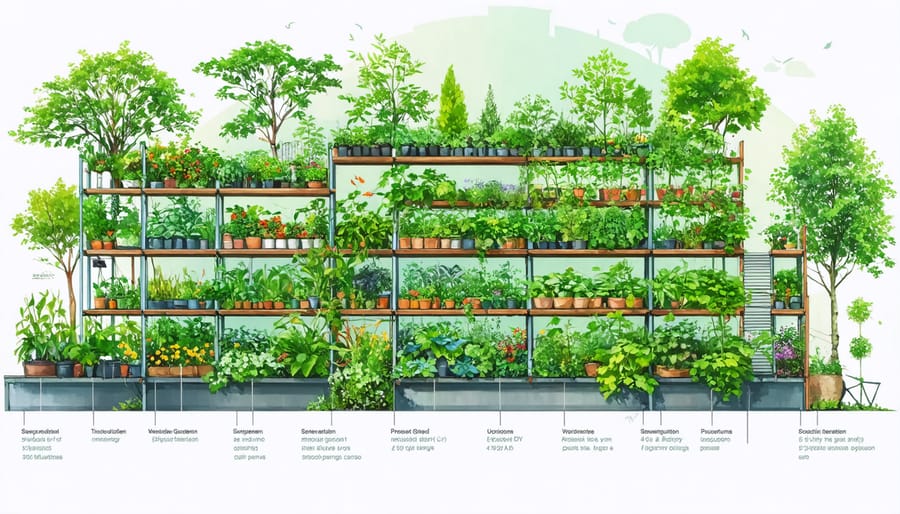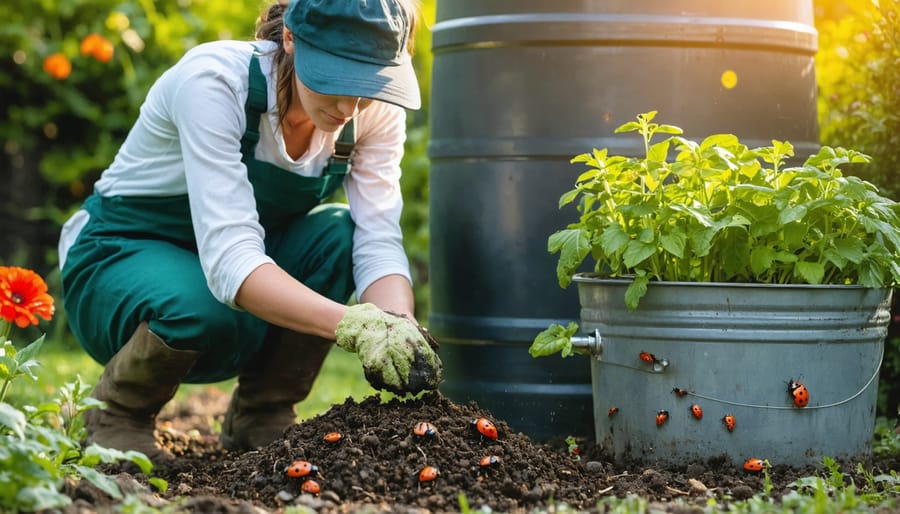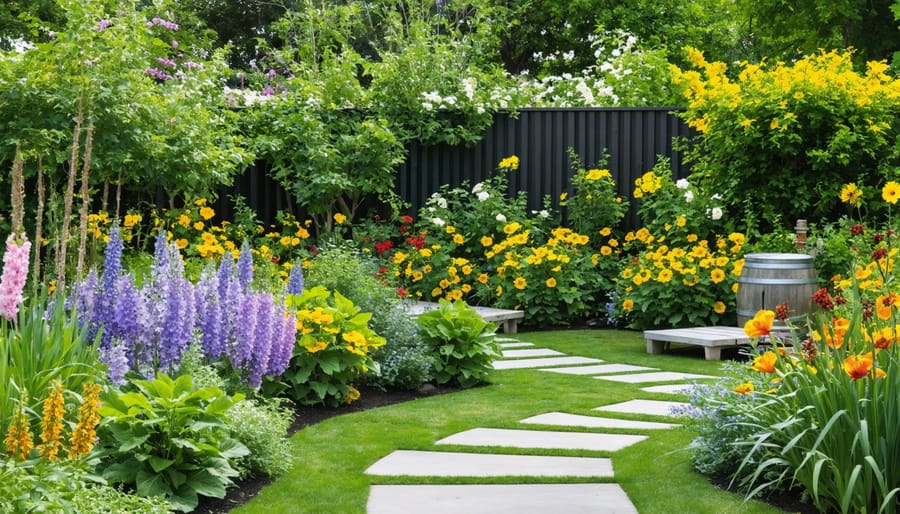Transform your urban space into a thriving ecosystem by integrating core permaculture principles into your daily gardening practices. Stack functions vertically by growing climbing vegetables alongside wall-mounted herb gardens, maximizing limited square footage while creating natural pest barriers. Design self-sustaining water systems using connected rain barrels and gravity-fed drip irrigation, reducing maintenance while nurturing your plants naturally. Build soil fertility through compact composting methods, including bokashi fermentation for kitchen scraps and worm towers that enrich multiple growing areas simultaneously. Establish beneficial plant communities by combining deep-rooted perennials with shallow-rooted annuals, creating resilient mini-ecosystems that thrive in containers and small garden beds. These space-efficient techniques work harmoniously to create abundant yields while regenerating urban environments, proving that even the smallest spaces can become productive permaculture havens.
Space-Maximizing Permaculture Design for Urban Settings
Vertical Growing Systems
Vertical growing systems are a game-changer for urban permaculture enthusiasts who want to maximize their growing space. By thinking upward instead of outward, you can double or even triple your growing area while creating beautiful living walls of edible and ornamental plants.
The simplest vertical growing method is using trellises for climbing plants like peas, beans, and cucumbers. You can build a basic trellis from bamboo poles and twine, or purchase ready-made metal or wooden options. For a more structured approach, consider installing a wall-mounted grid system where you can attach multiple growing containers at different heights.
Hanging systems are perfect for trailing plants and herbs. Try using repurposed guttering to create tiered growing channels, or hang multiple pot systems from sturdy hooks. Living walls, also known as green walls, take vertical growing to the next level by incorporating built-in irrigation systems and specialized growing pockets.
One of my favorite space-saving techniques is the pocket garden method. Using fabric hanging organizers or purpose-built vertical planters, you can create a lush wall of strawberries, lettuce, or herbs right outside your kitchen door. Remember to consider the weight of your system when fully watered, and ensure your mounting surface can handle the load.
For those with limited floor space, tower gardens offer an excellent solution. These systems can be hydroponically operated or soil-based, allowing you to grow dozens of plants in a footprint of just a few square feet.

Layered Growing Zones
Maximizing your growing space doesn’t mean you have to expand horizontally – think vertically! By implementing food forest layering techniques, you can create a thriving ecosystem that makes the most of every inch of your garden.
Start with tall trees or climbing plants as your canopy layer, which provide shade and support for lower-growing plants. Beneath these, incorporate smaller fruit trees or large shrubs as your understory. The shrub layer comes next, featuring plants like blueberries or currants. At ground level, plant herbs and vegetables that thrive in partial shade.
Don’t forget about the vertical spaces in between! Climbing plants like pole beans, cucumbers, and vining squash can weave through your layers, while root crops maximize the space below ground. Even mushrooms can find their place in shadier spots between plants.
This layered approach mimics natural forest systems, creating beneficial relationships between plants. Taller plants protect more delicate ones from harsh weather, while ground covers help retain moisture and suppress weeds. Best of all, you’ll harvest different crops from various heights throughout the season, making the most of your limited space while creating a beautiful, productive garden that practically takes care of itself.
Urban-Friendly Plant Guilds
Container Guild Systems
Container guild systems bring the power of permaculture to even the smallest spaces, making them perfect for balconies, patios, and urban gardens. These miniature ecosystems combine multiple plants that work together, supporting each other’s growth while maximizing limited space.
A classic container guild starts with a central “anchor” plant, such as a dwarf fruit tree or large herb, surrounded by companion plants at different heights. For example, a container with a dwarf lemon tree might include nitrogen-fixing oregano at its base, trailing nasturtiums to cover the soil, and climbing peas that can share the same support structure.
Here are some proven container guild combinations:
– Tomato + Basil + Marigolds + Parsley
– Strawberries + Chives + Thyme + Borage
– Peppers + Cilantro + Alyssum + Oregano
When planning your container guild, consider the following layers:
1. Tall central plants (main crop)
2. Medium-height supporters (typically herbs or flowers)
3. Ground cover plants (soil protection and moisture retention)
4. Root zone plants (shallow-rooted companions)
For best results, choose containers at least 18 inches deep and 24 inches wide. Ensure good drainage and use quality potting soil mixed with compost. Water deeply but less frequently to encourage deep root growth. Remember that container guilds need more frequent watering and feeding than in-ground gardens, as nutrients can be depleted more quickly in confined spaces.
Even a single well-planned container guild can provide herbs, vegetables, and flowers while creating a beautiful, productive mini-ecosystem on your doorstep.
Balcony Food Forests
Even with limited outdoor space, you can create a thriving food forest on your balcony or patio. The key is to think vertically and work with layers, just like natural forests do. Start by placing larger container plants like dwarf fruit trees or columnar apple trees at the back of your space. These will form your canopy layer and provide a backdrop for smaller plants.
Next, add a middle layer of shrubs in containers, such as blueberries, currents, or compact raspberry varieties. Below these, incorporate herbs and leafy greens that can cascade over pot edges or grow in hanging baskets. Think oregano, thyme, and trailing nasturtiums, which are both beautiful and edible.
Make the most of vertical space by installing trellises or wall-mounted planters. These are perfect for climbing plants like pole beans, cucumbers, and compact grape varieties. Don’t forget to include root crops in deeper containers – carrots, radishes, and potatoes can thrive in properly sized pots.
Create beneficial plant communities by grouping compatible species together. For example, plant strawberries as ground cover around the base of your dwarf fruit trees, with chives and marigolds nearby to deter pests naturally. Use self-watering containers and install a simple drip irrigation system to maintain consistent moisture levels.
Remember to consider your balcony’s specific conditions. Pay attention to wind exposure, sunlight patterns, and weight restrictions. Start small and gradually expand your forest as you learn what works best in your space. Even a modest balcony food forest can provide fresh herbs, fruits, and vegetables while creating a peaceful urban oasis.

Water Management in Urban Permaculture
Rainwater Harvesting
Rainwater harvesting is one of the simplest yet most effective ways to practice sustainability in an urban setting. Even with limited space, you can collect and use rainwater to support your garden while reducing your environmental impact and water bills.
The easiest way to start is by installing a rain barrel beneath your downspout. A standard 55-gallon barrel can collect hundreds of gallons of water throughout the rainy season. For those with more space, you can connect multiple barrels in series or opt for larger storage tanks. Remember to elevate your barrel slightly on concrete blocks or a sturdy platform to allow for easier access to the spigot.
Don’t have gutters? Consider creating a rain garden – a shallow depression in your yard that collects and filters rainwater naturally. Plant water-loving native species around the edges to help absorb excess water and create a beautiful, functional landscape feature.
For balcony gardeners, smaller collection systems work well too. Try attaching a mini-gutter to your balcony roof or installing a compact water butt. Even collecting water in buckets during rainfall can make a difference.
To maximize your harvested rainwater, pair it with efficient watering methods like drip irrigation or self-watering containers. During dry spells, your stored rainwater becomes a precious resource for keeping your garden thriving without relying on municipal water supplies.

Grey Water Systems
Grey water systems offer an excellent way to maximize water efficiency in your permaculture garden while reducing your environmental impact. These systems redirect gently used household water from activities like washing dishes, doing laundry, or showering directly to your garden beds, providing essential irrigation for your plants.
To set up a safe grey water system, start with water from relatively clean sources like bathroom sinks, showers, and washing machines. Avoid using water from toilets or kitchen sinks containing food particles. When choosing soaps and detergents, opt for natural, biodegradable products free from harmful chemicals, as these will be gentler on your plants and soil.
Simple grey water solutions can include redirecting washing machine discharge through food-safe hoses to your garden or installing branched drain systems that distribute shower water to multiple planting areas. For best results, allow grey water to flow through a mulch basin or constructed wetland before reaching your plants. This natural filtration helps break down any remaining soap residues and prevents water from pooling around plant roots.
Remember to check local regulations regarding grey water use, as requirements vary by location. Also, avoid using grey water on root vegetables or any crops where the edible portion comes in direct contact with the water. Instead, direct this water to fruit trees, ornamental plants, and deep-rooted perennials.
Urban Composting Solutions
Living in the city doesn’t mean you have to give up on composting! With creative small-scale urban composting methods, you can turn your kitchen scraps into black gold even in the smallest of spaces.
One of the most popular solutions is the bokashi system, which uses beneficial microorganisms to ferment organic waste in an airtight container. This odorless process is perfect for apartment dwellers and can handle everything from fruit peels to meat scraps. The resulting pre-compost can be buried in container gardens or shared with community gardens.
Vermicomposting is another excellent option for urban environments. Red wiggler worms can transform your kitchen waste into nutrient-rich castings in a compact bin that fits under your sink or on a balcony. These industrious creatures work quietly and efficiently, producing some of the finest compost you’ll ever use.
For those with a bit more space, tumbling composters are a fantastic choice. These sealed units can be rotated regularly to mix materials and maintain proper aeration, speeding up the decomposition process while keeping pests at bay. Many models are designed with urban aesthetics in mind, looking more like modern garden furniture than traditional compost bins.
Smart layering techniques can help maximize efficiency in any composting system. Alternate your green materials (kitchen scraps, coffee grounds, fresh plant matter) with brown materials (dried leaves, paper, cardboard) to maintain the perfect balance for decomposition. Keep a small container in your kitchen for collecting scraps, and transfer them to your chosen composting system every few days.
Remember to monitor moisture levels and maintain good air circulation, regardless of which method you choose. With proper management, these urban composting solutions can help you reduce waste while creating valuable nutrients for your container gardens and houseplants.
As we’ve explored throughout this guide, urban permaculture offers endless possibilities for creating sustainable, productive spaces in our cities. By embracing these practices, you’re not just growing food – you’re fostering biodiversity, reducing waste, and building resilient communities. Remember that permaculture is a journey, not a destination. Start small with a single container garden or herb spiral, and gradually expand your practice as you gain confidence and experience.
The beauty of urban permaculture lies in its flexibility and adaptability. Whether you have a tiny balcony, a shared rooftop, or a modest backyard, there’s always room to implement these principles. Focus on vertical growing, companion planting, and maximizing space efficiency. Every small step counts, from collecting rainwater to composting kitchen scraps.
Don’t feel overwhelmed by trying to implement everything at once. Choose one or two practices that resonate with you and build from there. Connect with local permaculture groups, attend workshops, and share your experiences with others. The permaculture community is wonderfully supportive and always eager to share knowledge.
As you begin your urban permaculture journey, remember that mistakes are valuable learning opportunities. Observe your space, experiment with different techniques, and adapt your approach based on what works best in your unique environment. Your urban oasis awaits – it’s time to start creating it!




